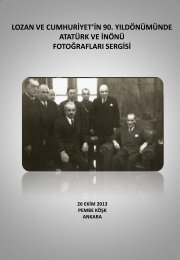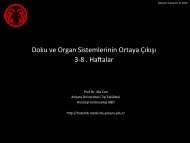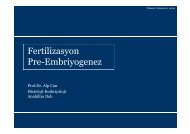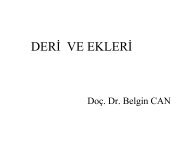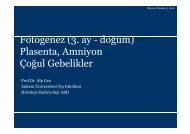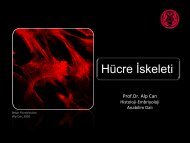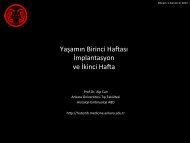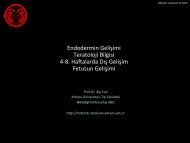dosya indir - ankaratiphastaneleri
dosya indir - ankaratiphastaneleri
dosya indir - ankaratiphastaneleri
Create successful ePaper yourself
Turn your PDF publications into a flip-book with our unique Google optimized e-Paper software.
Avrupa Resüsitasyon Konseyi 2005 Resüsitasyon K›lavuzu<br />
S127<br />
study of peripheral to central circulation delivery times between<br />
intraosseous and intravenous injection using a radionuclide<br />
technique in normovolemic and hypovolemic canines. J Emerg<br />
Med 1989; 7:123-7.<br />
115. Warren DW, Kissoon N, Sommerauer JF, Rieder MJ. Comparison<br />
of fluid infusion rates among peripheral intravenous and<br />
humerus, femur, malleolus, and tibial intraosseous sites in normovolemic<br />
and hypovolemic piglets. Ann Emerg Med 1993;<br />
22:183-6.<br />
116. Brickman KR, Krupp K, Rega P, Alexander J, Guinness M.<br />
Typing and screening of blood from intraosseous access. Ann<br />
Emerg Med 1992; 21:414-7.<br />
117. Johnson L, Kissoon N, Fiallos M, Abdelmoneim T, Murphy S.<br />
Use of intraosseous blood to assess blood chemistries and hemoglobin<br />
during cardiopulmonary resuscitation with drug infusions.<br />
Crit Care Med 1999; 27:1147-52.<br />
118. Ummenhofer W, Frei FJ, Urwyler A, Drewe J. Are laboratory values<br />
in bone marrow aspirate predictable for venous blood in<br />
pOEDiatric patients? Resuscitation 1994; 27:123-8.<br />
119. Kissoon N, Idris A, Wenzel V, Murphy S, Rush W. Intraosseous<br />
and central venous blood acid-base relationship during cardiopulmonary<br />
resuscitation. Pediatr Emerg Care 1997; 13:250-<br />
3.<br />
120. Abdelmoneim T, Kissoon N, Johnson L, Fiallos M, Murphy S.<br />
Acid-base status of blood from intraosseous and mixed venous<br />
sites during prolonged cardiopulmonary resuscitation and<br />
drug infusions. Crit Care Med 1999; 27:1923-8.<br />
121. Venkataraman ST, Orr RA, Thompson AE. Percutaneous infraclavicular<br />
subclavian vein catheterization in critically ill infants<br />
and children. J Pediatr 1988; 113:480-5.<br />
122. Fleisher G, Caputo G, Baskin M. Comparison of external jugular<br />
and peripheral venous administration of sodium bicarbonate<br />
in puppies. Crit Care Med 1989; 17:251-4.<br />
123. Hedges JR, Barsan WB, Doan LA, et al. Central versus peripheral<br />
intravenous routes in cardiopulmonary resuscitation. Am J<br />
Emerg Med 1984; 2:385-90.<br />
124. Neufeld JD, Marx JA, Moore EE, Light AI. Comparison of intraosseous,<br />
central, and peripheral routes of crystalloid infusion<br />
for resuscitation of hemorrhagic shock in a swine model. J<br />
Trauma 1993; 34:422-8.<br />
125. Stenzel JP, Green TP, Fuhrman BP, Carlson PE, Marchessault RP.<br />
Percutaneous femoral venous catheterizations: a prospective<br />
study of complications. J Pediatr 1989; 114:411-5.<br />
126. Kleinman ME, Oh W, Stonestreet BS. Comparison of intravenous<br />
and endotracheal epinephrine during cardiopulmonary<br />
resuscitation in newborn piglets. Crit Care Med 1999;<br />
27:2748-54.<br />
127. Efrati O, Ben-Abraham R, Barak A, et al. Endobronchial adrenaline:<br />
should it be reconsidered? Dose response and haemodynamic<br />
effect in dogs. Resuscitation 2003; 59:117-22.<br />
128. Howard RF, Bingham RM. Endotracheal compared with intravenous<br />
administration of atropine. Arch Dis Child 1990;<br />
65:449-50.<br />
129. Prengel AW, Lindner KH, Hahnel J, Ahnefeld FW. Endotracheal<br />
and endobronchial lidocaine administration: effects on plasma<br />
lidocaine concentration and blood gases. Crit Care Med<br />
1991; 19:911-5.<br />
130. Crespo SG, Schoffstall JM, Fuhs LR, Spivey WH. Comparison of<br />
two doses of endotracheal epinephrine in a cardiac arrest model.<br />
Ann Emerg Med 1991; 20:230-4.<br />
131. Lee PL, Chung YT, Lee BY, Yeh CY, Lin SY, Chao CC. The optimal<br />
dose of atropine via the endotracheal route. Ma Zui<br />
Xue Za Zhi 1989; 27:35-8.<br />
132. Hahnel JH, Lindner KH, Schurmann C, Prengel A, Ahnefeld<br />
FW. Plasma lidocaine levels and PaO2 with endobronchial administration:<br />
dilution with izotonik sodyum klorür or distilled<br />
water? Ann Emerg Med 1990; 19:1314-7.<br />
133. Jasani MS, Nadkarni VM, Finkelstein MS, Mandell GA, Salzman<br />
SK, Norman ME. Effects of different techniques of endotracheal<br />
epinephrine administration in pediatric porcine hypoxichypercarbic<br />
cardiopulmonary arrest. Crit Care Med 1994;<br />
22:1174-80.<br />
134. Steinfath M, Scholz J, Schulte am Esch J, Laer S, Reymann A,<br />
Scholz H. The technique of endobronchial lidocaine administration<br />
does not influence plasma concentration profiles and<br />
pharmacokinetic parameters in humans. Resuscitation 1995;<br />
29:55-62.<br />
135. Carcillo JA, Fields AI. Clinical practice parameters for hemodynamic<br />
support of pediatric and neonatal patients in septic<br />
shock. Crit Care Med 2002; 30:1365-78.<br />
136. Simma B, Burger R, Falk M, Sacher P, Fanconi S. A prospective,<br />
randomized, and controlled study of fluid management in<br />
children with severe head injury: lactated Ringer's solution versus<br />
hypertonic saline. Crit Care Med 1998; 26:1265-70.<br />
137. Rocha eSM. Hypertonic saline resuscitation. Medicina 1998;<br />
58:393-402.<br />
138. Katz LM, Wang Y, Ebmeyer U, Radovsky A, Safar P. Glucose<br />
plus insulin infusion improves cerebral outcome after asphyxial<br />
cardiac arrest. Neuroreport 1998; 9:3363-7.<br />
139. Longstreth WT, Jr., Copass MK, Dennis LK, Rauch-Matthews<br />
ME, Stark MS, Cobb LA. Intravenous glucose after out-of-hospital<br />
cardiopulmonary arrest: a communitybased randomized<br />
trial. Neurology 1993; 43:2534-41.<br />
140. Chang YS, Park WS, Ko SY, et al. Effects of fasting and insulininduced<br />
hypoglycemia on brain cell membrane function and<br />
energy metabolism during hypoxia-ischemia in newborn piglets.<br />
Brain Res 1999; 844:135-42.<br />
141. Cherian L, Goodman JC, Robertson CS. Hyperglycemia increases<br />
brain injury caused by secondary ischemia after cortical impact<br />
injury in rats. Crit Care Med 1997; 25:1378-83.<br />
142. Paul T, Bertram H, Bokenkamp R, Hausdorf G. Supraventricular<br />
tachycardia in infants, children and adolescents: Diagnosis,<br />
and pharmacological and interventional therapy. POEDiatric<br />
Drugs 2000; 2:171-81.<br />
143. Losek JD, Endom E, Dietrich A, Stewart G, Zempsky W, Smith<br />
K. Adenosine and pediatric supraventricular tachycardia in the<br />
emergency department: multicenter study and review. Ann<br />
Emerg Med 1999; 33:185-91.<br />
144. Roberts JR, Greenburg MI, Knaub M, Baskin SI. Comparison of<br />
the pharmacological effects of epinephrine administered by<br />
the intravenous and endotracheal routes. JACEP 1978; 7:260-<br />
4.<br />
145. Zaritsky A. Pediatric resuscitation pharmacology. Members of<br />
the Medications in Pediatric Resuscitation Panel. Ann Emerg<br />
Med 1993; 22(pt 2):445-55.<br />
146. Manisterski Y, Vaknin Z, Ben-Abraham R, et al. Endotracheal<br />
epinephrine: a call for larger doses. Anesth Analg 2002;<br />
95:1037-41, table of contents.<br />
147. Patterson MD, Boenning DA, Klein BL, et al. The use of highdose<br />
epinephrine for patients with out-of-hospital cardiopulmonary<br />
arrest refractory to prehospital interventions. Pediatr<br />
Emerg Care 2005; 21:227-37.<br />
148. Perondi MB, Reis AG, Paiva EF, Nadkarni VM, Berg RA. A comparison<br />
of high-dose and standard-dose epinephrine in children<br />
with cardiac arrest. N Engl J Med 2004; 350:1722-30.<br />
149. Carpenter TC, Stenmark KR. High-dose epinephrine is not superior<br />
to standard-dose epinephrine in pediatric in-hospital<br />
cardiopulmonary arrest. Pediatrics 1997; 99:403-8.<br />
150. Dieckmann R, Vardis R. High-dose epinephrine in pediatric<br />
out-of-hospital cardiopulmonary arrest. Pediatrics 1995;<br />
95:901-13.<br />
151. Berg RA, Otto CW, Kern KB, et al. High-dose epinephrine results<br />
in greater early mortality after resuscitation from prolonged<br />
cardiac arrest in pigs: a prospective, randomized study.<br />
Crit Care Med 1994; 22:282-90.<br />
152. Rubertsson S, Wiklund L. Hemodynamic effects of epinephrine<br />
in combination with different alkaline buffers during experimental,<br />
open-chest, cardiopulmonary resuscitation. Crit Care<br />
Med 1993; 21:1051-7.<br />
153. Somberg JC, Timar S, Bailin SJ, et al. Lack of a hypotensive ef-



